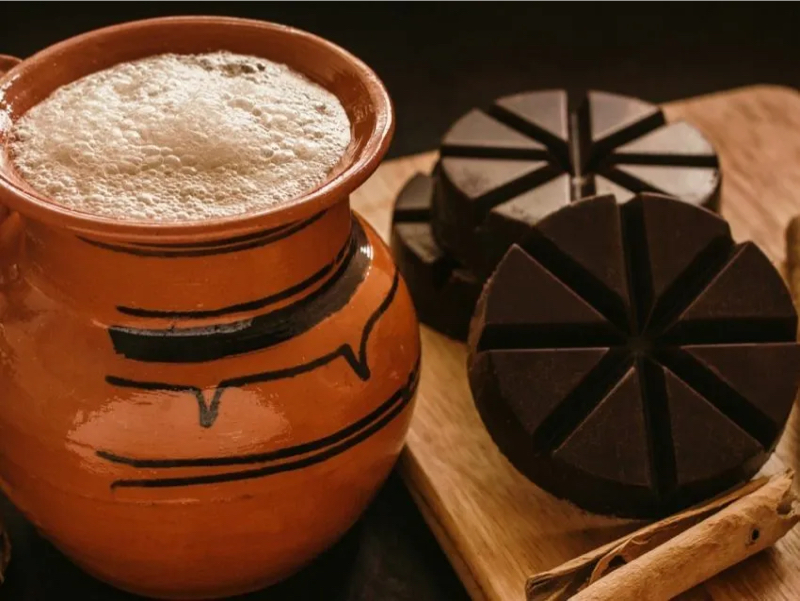Must-Buy Souvenirs and Unique Gifts in Mexico
Posted by Grace on August 30, 2023
When you're looking for things to buy in Mexico, you'll find a treasure trove of must-buy items that won't break the bank. Mexico is full of amazing things like its culture, history, and delicious foods. When you visit this fascinating country, don't forget to bring back special items with you. No matter if you love food, culture, or just want something unique, Mexico has gifts for everyone.
To help you discover the coolest things to bring back from your trip, I've put together this budget-friendly list of Mexican souvenirs.
Contents
Culinary Delights
1. Mexican Chocolate

What: Mexican chocolate is a tantalizing blend of cocoa, sugar, and sometimes spices like cinnamon. It's traditionally made using a stone grinding process that results in a rustic, grainy texture.
History: Chocolate has deep roots in Mexico, tracing back to the ancient civilizations of the Aztecs and Mayans. The word "chocolate" is derived from the Aztec word "xocolātl," which referred to a bitter cacao-based beverage.
Where to Find: You can find Mexican chocolate in local markets, supermarkets, and specialty stores throughout the country.
Price Range: Expect to pay around $5 to $15 for various forms of Mexican chocolate, depending on the brand and quality.
2. Mexican Coffee Beans
 The State of Chiapas is renowned for producing some of the country's finest coffee beans
The State of Chiapas is renowned for producing some of the country's finest coffee beans
What: Mexican coffee beans are renowned for their smooth, light-to-medium body and bright acidity. Varieties like Chiapas and Veracruz offer unique flavor profiles.
History: Coffee cultivation in Mexico has a history dating back to the 18th century when Spanish colonists introduced coffee plants.
Where to Find: You can explore local coffee shops, markets, and even coffee plantations for the freshest beans.
Price Range: Prices vary based on the quality and origin of the beans. Expect to spend around $10 to $20 per bag of premium Mexican coffee.
3. De la Rosa Mazapan
 My kids love this simple treat.
My kids love this simple treat.
What: De la Rosa Mazapan is a popular Mexican candy made from crushed peanuts and sugar. It has a crumbly texture and a delightful nutty flavor.
History: The concept of mazapan originated from Spain but was embraced and transformed into its own unique treat in Mexico.
Where to Find: You can find De la Rosa Mazapan in grocery stores, markets, and candy shops across Mexico.
Price Range: These treats are quite affordable, usually priced at around $1 to $2 for a pack.
4. Mole Sauce
 Doña María Mole, a popular brand of mole paste that holds a special place in Mexican cuisine.
Doña María Mole, a popular brand of mole paste that holds a special place in Mexican cuisine.
What: Mole is a rich and complex sauce made from ingredients like chocolate, chili peppers, spices, and more. It's often served with meat or poultry.
History: Mole has deep indigenous and colonial roots, with various regional variations throughout Mexico. It's a dish that carries centuries of tradition.
Where to Find: Many restaurants and markets offer pre-made mole paste, or you can buy the ingredients to make your own.
Price Range: Prices for pre-made mole paste can vary, but you can expect to spend around $5 to $15 for a jar.
Distinctive Drinks
1. Tequila
 Patrón, known for its premium tequilas and distinctive bottles. They produce a variety of tequilas, including silver (blanco), reposado, and añejo.
Patrón, known for its premium tequilas and distinctive bottles. They produce a variety of tequilas, including silver (blanco), reposado, and añejo.
What: Tequila is a distilled spirit made from the blue agave plant. It ranges in flavor from earthy and vegetal to smooth and caramel-like.
History: Tequila is deeply tied to Mexican culture and history, originating from the region of Jalisco.
Where to Find: Tequila is widely available in liquor stores and duty-free shops across Mexico.
Price Range: The price of tequila varies widely based on the brand, aging process, and quality. You can find bottles ranging from $20 to $100 or more.
2. Mezcal
 Gusano Rojo Mezcal was one of the first mezcals to be exported from Mexico, and it is still widely distributed throughout the globe to this day.
Gusano Rojo Mezcal was one of the first mezcals to be exported from Mexico, and it is still widely distributed throughout the globe to this day.
What: Mezcal is another agave-based spirit, but it's often smokier and more robust in flavor compared to tequila.
History: Mezcal has ancient origins, with indigenous communities producing it long before the arrival of the Spanish.
Where to Find: You'll find mezcal in liquor stores and markets, especially in regions where it's produced, like Oaxaca.
Price Range: Mezcal prices can vary significantly. Expect to pay around $30 to $60 for a good-quality bottle.
3. Mexican Coca-Cola

What: Mexican Coca-Cola is known for its distinctive taste because it's sweetened with cane sugar instead of high fructose corn syrup.
History: Mexican Coca-Cola's recipe harks back to the original formulation of Coca-Cola, using cane sugar as the sweetener.
Where to Find: You can find Mexican Coca-Cola in grocery stores, convenience stores, and restaurants throughout Mexico.
Price Range: Prices are similar to those of regular Coca-Cola, typically ranging from $1 to $2 for a bottle.
Cultural Souvenirs
1. Lucha Libre Mask

What: Lucha libre masks are colorful, intricate masks worn by wrestlers in the Mexican sport of lucha libre. They're also popular as decorative items.
History: Lucha libre, or "free fight," has been a part of Mexican culture since the early 20th century.
Where to Find: You can find lucha libre masks in markets, souvenir shops, and online stores dedicated to Mexican crafts.
Price Range: Prices vary depending on the intricacy of the mask's design, ranging from $10 to $50 or more.
2. Talavera Pottery

What: Talavera pottery is a type of majolica earthenware known for its vibrant colors and intricate hand-painted patterns.
History: Talavera pottery has Spanish and Moorish origins, with a rich history in Mexican art and culture.
Where to Find: Look for talavera pottery in local markets, pottery studios, and specialty shops.
Price Range: Prices depend on the size and intricacy of the piece. Smaller items can start around $10, while larger ones can go up to $100 or more.
3. Mexican Margarita Glassware
 What: Mexican margarita glassware often features vibrant colors and hand-blown craftsmanship, adding a touch of Mexican flair to your drinkware collection.
What: Mexican margarita glassware often features vibrant colors and hand-blown craftsmanship, adding a touch of Mexican flair to your drinkware collection.
Where to Find: You can find these glasses in local markets, souvenir shops, and even some glassblowing studios.
Price Range: Prices vary based on the intricacy of the design and the size of the set. Expect to pay around $10 to $20 for a set of two glasses.
4. Huipil Womenswear

What: Huipil is a traditional women's garment characterized by its intricate embroidery and vibrant colors. It's a symbol of indigenous culture.
History: The huipil dates back to pre-Columbian times and has evolved over the centuries.
Where to Find: Indigenous markets and artisanal shops are great places to find authentic huipils.
Price Range: Prices vary depending on the complexity of the embroidery and the region. You can find huipils starting around $20 and going up to $100 or more for highly ornate pieces.
5. Day of the Dead Figurines

What: Day of the Dead figurines and decorations are iconic symbols of Mexico's Dia de los Muertos (Day of the Dead) celebration, honoring deceased loved ones.
History: Dia de los Muertos is an ancient indigenous tradition that has blended with Catholicism over time.
Where to Find: You can find Day of the Dead figurines in markets and craft shops, especially leading up to the holiday.
Price Range: Prices vary based on the size and intricacy of the figurines. Expect to pay around $5 to $20 for individual figurines.
6. Alebrijes

What: Alebrijes are colorful, fantastical creatures carved from wood. They're a unique and vibrant representation of Mexican folk art.
History: Alebrijes were first created in the 1930s by artist Pedro Linares, inspired by a dream.
Where to Find: Artisan markets and galleries are excellent places to discover these imaginative creations.
Price Range: Prices depend on the size and intricacy of the alebrije. Small pieces start around $20, while larger and more elaborate ones can go up to $100 or more.
7. Molinillo Whisk

What: A molinillo is a traditional wooden tool used for frothing chocolate in the preparation of hot chocolate.
History: Molinillos have been used for centuries in Mexico to create the frothy consistency that characterizes Mexican hot chocolate.
Where to Find: You can find molinillos in markets, specialty shops, and even some kitchenware stores.
Price Range: Prices vary depending on the size and craftsmanship. You can find molinillos starting around $5 to $10.
8. Sombreros

What: Sombreros are wide-brimmed hats that have become iconic symbols of Mexico. While they're often associated with festivals and celebrations, they're also practical for sun protection.
History: The sombrero's origins date back to Spanish colonial times.
Where to Find: You can find sombreros in markets, souvenir shops, and even specialized hat stores.
Price Range: Prices vary based on the size, material, and intricacy of the hat. Expect to pay around $10 to $50 or more.
9. Frida Kahlo Souvenirs

What: Souvenirs featuring the iconic artist Frida Kahlo often include prints, posters, and various artistic representations.
History: Frida Kahlo is a celebrated Mexican artist known for her unique self-portraits and impactful art.
Where to Find: Frida Kahlo souvenirs can be found in art galleries, museums, and souvenir shops across Mexico.
Price Range: Prices vary depending on the item and its quality. You can find Frida Kahlo souvenirs starting around $5 and going up to $30 or more for high-quality prints or collectibles.
10. Handmade Mexican Hammock

What: Handmade Mexican hammocks are woven from cotton or nylon threads, creating a comfortable and breathable lounging space.
History: Hammocks have been used in indigenous Mexican cultures for centuries as practical bedding and seating.
Where to Find: You can find handmade hammocks in markets and artisanal shops, especially in coastal regions.
Price Range: Prices vary based on the size, material, and craftsmanship. You can find hammocks starting around $20 and going up to $100 or more for larger, more intricate designs.
11. Taxco Silver Jewelry

What: Taxco is known for its exceptional silver craftsmanship. You can find an array of silver jewelry, including rings, necklaces, bracelets, and more.
History: Taxco's silversmithing tradition dates back to the pre-Columbian era but gained prominence in the 20th century.
Where to Find: Look for silver jewelry in markets, jewelry shops, and artisanal boutiques, especially in Taxco.
Price Range: Prices vary based on the complexity of the design and the quality of the silver. You can find silver jewelry pieces starting around $20 and going up to several hundred dollars for intricate, high-quality items.
Final Words
When hunting for must-buy items in Mexico, you'll discover a variety of affordable and interesting things to buy in Mexico.
Now you know the coolest things to bring back from Mexico! Just make sure you have enough space in your luggage!




